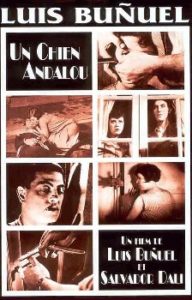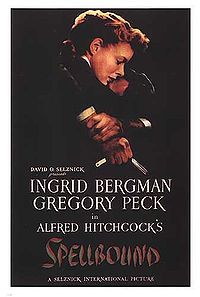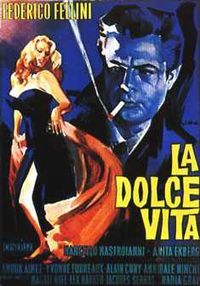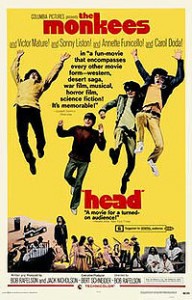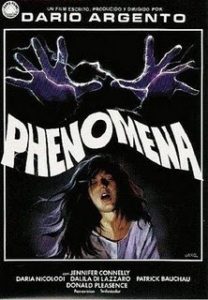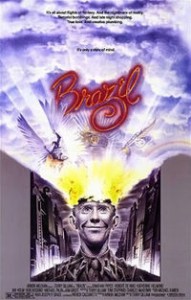What’s “Surreal”, Man? | DaysAreNumbers
Surreal. Surreal. It’s one of those words, isn’t it? It seems to me that often people aren’t 100% sure of what it actually really means exactly, but it still gets used an awful lot. A bit like “ironic”. However, a quick glance in the dictionary tells us that surreal means: 1. Having qualities attributed to or associated with surrealism, and 2. Having an oddly dreamlike quality. Of course, dreams are strange, bizarre and often unsettling, so it’s little wonder that the word surreal is often attributed to things that bear one, or all, of these qualities.
When I came to chose which films I would cover for Days Are Numbers’ Surreal Week, I was a little bit daunted not only by the exact definition of the word surreal, but by the sheer number of films that could potentially be classified as surreal. With that in mind, I’ve decided instead to look at some of the kinds of films that are often described as surreal, and we’ll see how many of them actually cut the mustard (which is a pretty surreal saying in itself, if you think about it… You can’t really cut mustard, can you?). This method will also handily double as a whistle-stop tour of surrealism’s influence on film in general.
So, follow me now through the looking glass, and don’t dilly-”Dali”! Groan.
The Surreal Deal
If we refer back to the first part of the definition of surreal, we may want to clarify what exactly surrealism itself is supposed to be. Well, as I’m sure you’re all already aware (but I’m going to tell you anyway!), surrealism was an art and literature movement started in the 1920s by the likes of Andre Breton, Man Ray, Antonin Artaud, and yes, Salvador Dali. Surrealism was all about creating a forum for the mind-boggling, the eccentric and the shocking in the arts, and while this was easily achieved on canvas and paper (provided you had the talent, of course), nascent film technology was a bit more difficult to master. Many of the movement’s founding members gave it a go however, and with some very special results.
Early cinema was often pretty bloody strange anyway, as anyone who has seen George Melies’ A Trip to the Moon or anything from the German expressionist movement can testify. Surrealism proper takes it’s bow onscreen in 1928 with The Seashell and the Clergyman, directed by the largely overlooked Germaine Dulac, and scripted by Artaud. This was overshadowed the following year, however, by the infamous Un Chien Andalou, a collaboration between Spanish director Luis Bunuel and his fellow countryman Dali. Anyone who’s ever done any kind of film studies should be intimately familiar with Un Chien Andalou, featuring as it does several of the most pored over sequences in cinema history, including the notorious “razor slitting eye/moon passing cloud” opening. Un Chien Andalou is a fine and important film, but how much you enjoy it may well depend on how interested you are in the surrealist movement, as it is a film that almost exclusively reflects their aims and interests.
Bunuel would go on to have a long and varied career without ever fully losing interest in surrealism, and traces of it can be found in much of his later work, including such critical triumphs as The Exterminating Angel, Belle de Jour, and The Discreet Charm of the Bourgeoisie. Dali, on the other hand, will always be remembered primarily for his painted work, but his adventures in, not to mention influence on, cinema would continue…
Dali Goes to Hollywood
The influence of surrealism on mainstream culture would be profound, if not always immediately traceable, and among it’s keenest students were some of the most widely watched American cartoonists of the 30s and 40s. Animators at Warner Bros.’ aptly named Looney Toons, home to many beloved characters including Bugs Bunny and Daffy Duck, gleefully lapped up the more zany elements of surrealism and applied them to their cartoon frolics. Even their more traditionally straight-laced rivals at Disney began taking their cue from Dali et al, with nutty ol’ Walt himself even beginning, but sadly never finishing, a direct collaboration with Dali on a short called Destino.
One Hollywood assignment that Dali did manage to finish, however, was his contribution of a frankly incredible, and still powerful, dream sequence to Alfred Hitchcock’s psychological thriller, Spellbound. Dali concieved and designed the revolutionary sequence, the direction of which was overseen by Things to Come helmer William Cameron Menzies, rather than Hitchcock himself, whose relationship with producer David O. Selznick was rather frayed at the time. Indeed, Spellbound itself is far from Hitchcock’s best film, and is probably best remembered today for Dali’s dream sequence alone. A startling addition to the film, it sees Gregory Peck trapped in a nightmarish, recognisably Dali-esque world of gigantic, staring eyes (which get sliced in two, a la Un Chien Andalou), mysterious figures, and bizzaro landscapes.
Spellbound was released in 1945, the year the Second World War ended. It’s at this point that the shadow of surrealism begins to fade away in mainstream American culture, at least for the time being. It’s not difficult to see why, either. Following their horrific experiences, a generation of war-hardy Americans decided to move away from the strange and unknown, instead reaffirming their national identity as wholesome, pure, and rather sterile, traits reflected in the popular entertainment of the time (think Leave it to Beaver etc.). In order to keep track of surrealism, we’re going to have to head elsewhere…
The Surreal World
Of course, Europe also experienced some “difficulties” during the Second World War, and while surrealism was pushed down on the agenda on that continent also, it was for slightly different reasons. From the early 50s onwards, European directors would begin to work with newly available light-weight equipment and very soon a “new wave” of independent filmmaking was developing in almost every country. Initially at least, and led by Italian neorealism, these movements were influenced by the very leftist, Soviet notion that all true art should possess a poetic realism, and ideally focus on the day-to-day lives of the proleteriat. Not much scope for surrealism there, of course, but within time almost every director of the Italian neorealism movement would add a splash of the fantastical to their filmmaking, most notably Federico Fellini.
Ah, Fellini. Possibly the only film director to have warranted his own word; Felliniesque. But what does it mean? Well, it’s a catch-all adjetive used to describe the great man’s most famous films, including the likes of La Dolce Vita, 8 1/2, and Juliet of the Spirits, all of which could be described as colourful, fanciful, and peculiar. Surreal, in other words? Certainly to some extent, but I personally believe that Felliniesque should be interpreted as having one major difference from straight-up surrealism; namely that Fellini’s fantastical occurences usually take place in an everyday, perfectly explainable context. Think of the gigantic fish pulled from the sea at the end of La Dolce Vita. Yes, it’s strange, but it could probably happen. The record player blaring out the sound of church bells sat beside a real, disused church bell in Nights of Cabiria also springs to mind. It would seem that Federico rather ingeniusously found a way to import the surreal into everyday life.
The French New Wave is probably the post-war film movement most widely regarded as being somewhat surreal, but it too began under the influence of social realism, with the rural dramas of Agnes Varda and Claude Chabrol leading the way. It is possible to see traces of surreal humour in many of it’s later films, however, and efforts from Alain Resnais (Last Year at Marienbad) and Louis Malle (Zazie dans la metro) are as straight-up surreal as cinema gets; although I would argue that the output of the movement’s most famously “out-there” director, Jean-Luc Godard, couldn’t be described as truly surreal (too cynical and satirical, if ya ask me). Interestingly, possibly the most surreal international film movements of the era sprang from the east, the same breeding ground as social realism. Anyone who supposes that filmmaking under communist regimes was always drab or stilted should check out such fare as Czechoslovakia’s bonkers anarcho-feminist caper Daisies, or the East German children’s classic The Singing Ringing Tree and have their minds duly blown.
Feed your Head
When I started thinking about what films to include in this here surreal special, I instinctively decided that I should shy away from anything that could be percieved as psychedelic. But now that I’ve decided to take a more general look at the influence on surrealism in cinema, I’m going to attempt to explain why. Namely, that I think psychedelia is a completely different, albeit superficially similar, school of thought to surrealism. In much the same way that I find Godard a bit to calculating to be considered a genuine surrealist, I also find the movers and shakers of the Swinging 60s a bit too loose and, quite often, too vacuous. It was a movement primarily based on getting out of your skull, was it not?
That’s not to say that I don’t love psychedelic things, as I very much do, and I also concede that the aforementioned superficial similarity between all things psychedelic and surreal at least permits us to have a look at a handful of films from the era. My own personal all-time favourite psychedelic film is probably The Monkees’ vehicle Head, a freewheeling, almost sociopathic attempt to deconstruct the public image of the manufactured mop tops by having them mock a disabled cowboy, fraternise with Frank Zappa’s talking cow, and battle a giant Victor Mature, among other activities. Bob “Five Easy Pieces” Rafelson directed and co-wrote the script with none other than Jack Nicholson, who also contributed lyrics to the film’s fine soundtrack. Of course, you can’t talk about great psychedelic music without mentioning The Beatles, and their 1967 TV special Magical Mystery Tour is also a treasure trove of bizarre delights, even if it is notoriously uneven and lacks Head’s dark edge.
So intrinsically linked were psychedelia and music that it’s hard to find a psychedelic film without some kind of popular musician attached to it somewhere. Kooky Brit drama Wonderwall (yes, that’s where he got it from) had George Harrison twanging the soundtrack, and Nic Roeg and Donald Cammel’s dark crime drama Performance famously boasted Mick Jagger in the lead. In fact, the only psychedelic films I can find that don’t have some immediately obvious rock ‘n’ roll connection are the ultra-strange, and often completely mindblowing, westerns and fantasy fables of mad Chilean mystic Alejandro Jodorowski. But even then a little research shows that both of his most famous films, El Topo and Holy Mountain, were made with the help of late-era Beatles manager Allen Klein and that both were also enthusiastically supported by messrs Harrison and John Lennon! Still, they’re both great films, and due to their allegorical and philosophical stylings, they’re probably the closest psychedelic cinema comes to true surrealism.
A Nightmarelike Quality?
I would argue that the most surreal of all genres is horror. Yes, there are probably surreal variants of films from every genre, from comedy (Jacques Tati, Jerry Lewis) to westerns (generally those of the spaghetti variety, most notably Giulio Questi’s staggering Django Kill… If You Live, Shoot!). But horror, by it’s very nature, is the genre that most readily relies on the uncanny, the otherwordly, and the unusual to do it’s job, and these traits serve to align it closely with many fundamental aspects of surrealism. Just think of how many renowned horror films contain surreal elements, and you’ll find that the list is almost endless; The Wicker Man, Don’t Look Now, Dawn of the Dead, Rosemary’s Baby etc.
More than anything else, the one motif regularly used in horror that links it to surrealism is it’s use of dreams, or rather nightmares. The Nightmare on Elm Street series is undoubtedly the most famous example of this, but a personal favourite of mine is the framing device used by Ealing’s celebrated portmanteau film, 1945’s Dead of Night, which sees the narrator trapped in a recurring nightmare. Another great example of this is The Slayer, a little known slasher film from 1982, which contains a number of similarities to A Nightmare on Elm Street, but was in fact made two years before. In it a mysterious, barely glimpsed killer stalks his victim in both her dreams and her everday reality, and very fittingly, his victim just so happens to be a surrealist painter by trade!
In fact, of all modern filmmakers I can think of, the one who strikes me as having arguably the most surrealistic bent is none other than Italian horror maestro Dario Arento. Practically every film Argento has made since returning to the horror genre in 1975 (following a brief detour into westerns) has come with a generous side order of dark surrealism. Consider the schizophrenic logic of Profondo Rosso, Suspiria’s dark fairytale theatrics, or 1980’s Inferno as a whole, which almost feels like Spellbound’s Dali dream sequence feverishly stretched to breaking point over the duration of an entire film. As dazzling as Inferno is, however, I suspect Argento’s most authentically surreal film may be one of his most maligned; Phenomena. Appearing five years after Inferno, and initially released in many territories as Creepers, Phenomena boasts a beguiling plot that is so multi-faceted it is scarcely believable. Featuring sleepwalking, telepathic communication with insects, a razorblade-weilding chimp, and a murderous dwarf, it might require a few viewings of Phenomena for you to take it all in, but surely that’s the way any surrealist worth his salt would want it.
Back to Sur-reality
So, what lasting influence has surrealism had on modern cinema? Well, it’s hard to gage. It can’t be denied that we live in a time when bizarre images and juxtapositions are more prevelant in mainstream media than ever before, but that’s not necessarily a good thing. It would seem that even surrealism has been harnessed as yet another stylistic weapon of choice in our ever more corporate culture, and you only have to switch on your television set to see any number of bizarre advertisements selling any number of dull products.
What you won’t see, however, is anything really, genuinely, dangerously strange. Modern surrealism may be pervasive, but it has also been sanitised. That’s why I can’t really think of any modern films that I could really bring myself to describe as thoroughbred surreal. I could mention either of Michel Gondry’s popular efforts Eternal Sunshine of the Spotless Mind or The Science of Sleep, but aside from the fact that I don’t particularly like either film, they also smack somewhat of false surrealism. It seems to me that the point of both of those films is that they’re supposed to be surreal, so therefore they can’t really be properly surreal, can they? It all seems a bit forced. The same goes for the films of David Lynch, although I’ll give him the sublime and disturbing Eraserhead, which also helps back up my horror-as-surrealism theory. Thanks, Dave!
Really, one of the few modern films I can think of that I would unequivocally classify as being surreal is Terry Gilliam’s Brazil, and that was made over 25 years ago! Perhaps still best known as the man behind the madcap animations on Monty Python, Gilliam’s most recent films may have a tang of whimsical surrealism about them themselves, but Brazil remains as razor-sharp as the very razor that Bunuel and Dali dragged across an eyeball all those years ago. A kind of Fritz Lang-directed revue of George Orwell’s 1984, the film depicts a dystopian future in which human life is very cheap and all the better for it, as bungling bureaucracy is steadily swallowing it up. It’s this grotesque humour, combined with Gilliam’s off-kilter visual style, that marks Brazil out as not only a great film, but a truly surreal one, also

